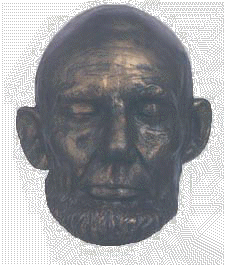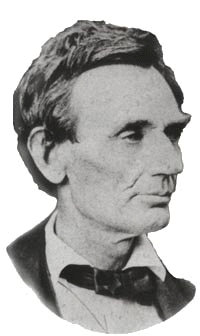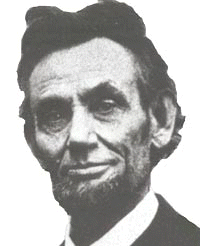Abraham Lincoln Art Gallery. ComLincoln Store Bronze Busts Abraham Lincoln - Limited Edition - Bronze Art Sculpture Portrait Busts The Abraham Lincoln Art Gallery presents for collector and corporate art purchase... two original, limited edition, life size, bronze sculpture portrait busts: President Abraham Lincoln entitled "Immortal Conscience" and Lawyer Abraham Lincoln entitled "Prairie Lawyer." These fine art bronze portrait sculpture busts by artist James J. Nance are the result of years of dedicated effort and are available as a set or individually. Early castings of this Lincoln bronze portrait edition have already been acquired by the Lincoln Home National Historic Site, Lincoln-Herndon Law Office State Historic Site, University of Tennessee College of Law, Lincoln National Life Insurance, and various private collectors. |
|
Welcome to the
Abraham Lincoln Art Gallery
American Presidential Original Art, Sculpture, Prints and more.
Abraham Lincoln Limited Edition Original Art
by Sculptor James J. Nance
Made In America
Life Size Bronze Busts
For more detailed information on each of our products click the buttons below
Back to all products menu
|
|
||
Immortal Conscience Bust$15,000 |
Matched Set of Both Busts $27,000 |
Prairie Lawyer Bust$15,000 |
|
|
||
Life Size Bronze PortraitsSpecificationsEdition Size -- 35 SetsCopyright -- 1994Size -- 26 x 18 inchesMaterial -- Cast BronzeWeight each -- 50 lbsPatina -- CustomPrice Each Bust -- $15,000Price for matched set --$27,000Certificate of Authenticity
Abraham Lincoln Bronzes cast inLoveland, ColoradoUnited States of AmericaPhotographs by Mel Schockner, Loveland Colorado |
||
|
|
|
|
|
|
||
|
|
||
PatinaDue to the illumination from photographic lights, sculptural patinas are very difficult to photograph. Since these castings have a bronze surface, the patina is hand applied using traditional bronze patina techniques. The color is a rich dark aged brown with a hint of red overlaying a golden undercoat. The brown patina is partially hand rubbed back to reveal varied and complex golden bronze highlights which are evident on raised areas contrasted by subtle shadows in recessed areas. The resulting patina is rich and traditional and will appear different in different light settings. In a dark room the patina will appear dark and aged but under light the incredible golden brown patina will be revealed. Under direct sunlight or the photo flood lights used in these photographs, the finish will appear brighter and lighter than normal. The areas on the busts which are normally black such as hair, beard, suspenders, and tie and coat have a very subtle black patina applied over the finish which is then rubbed back. To prevent tarnishing, the patina is sealed with a lacquer coating and buffed with bronze paste wax. Although the surface is durable, care should be exercised to avoid scratches with metallic objects. Polish the casting with a dry soft dustcloth and once or twice a year use a small amount of paste wax.
Searching for Lincoln's SpiritAs a member of the Abraham Lincoln Association and the Lincoln Forum, and a life long Lincoln Admirer, I have long desired to create an original portrait tribute to this great American. As the project developed, I realized that the key to understanding President Lincoln's personality lay in appreciating his development as a "Prairie Lawyer." His early political career and his years of tireless work as an attorney, defending the Constitution and the common man, laid the foundation of his strong character and political integrity that would guide President Lincoln through the most difficult period in our nation's history. When Mr. Lincoln moved from Springfield to Washington D.C., the nation was moving into war. During the next four years, the face of Abraham Lincoln became a mirror of the soul of the nation, indelibly etched with the turmoil of a struggling democracy. In a very real sense, Mr. Lincoln's physical, emotional, and intellectual transformation paralleled the transformation of America. Yet for all these changes, he was still the same man-the practical prairie lawyer from Illinois. Abraham Lincoln may have been the only man alive who could have presided over the Civil War to reunite the nation and abolish slavery. Why was he different, what aspects of his character gave him the uncanny ability to weigh the past, present, and future, to clearly see both sides of any issue and to arrive at a common sense solution? Why, above all others, did he posses the self reliance and determination to see the job through? What were Mr. Lincoln's hopes and aspirations, his agonies and torments? These are the questions I ask myself every time I view his face. When I tried to capture the spirit and character of this great man, I realized that since both periods of his life were so intimately intertwined, two portraits- attorney and president- were necessary to fulfill my vision of Mr. Lincoln. Only through two portraits could I show the transition and the struggle, the strength and the triumph, and the mortal cost of that triumph. The resulting twin portraits are therefore spiritually, artistically, and intellectually bonded as a single work. When both portraits are experienced together, the viewer can feel the pressures and changes which molded Lincoln's destiny and the destiny of America. I hope that these portraits will contribute artistically to a more intimate understanding of Mr. Lincoln. In honor of all all that they represent, I have called them: A Portrait of Transition: "Prairie Lawyer" and "Immortal Conscience."
Researching Abraham Lincoln's ImageWhen this project began, I collected a great many pictures of Mr. Lincoln and enlarged them to life size copies in my darkroom. I soon realized that every picture of Mr. Lincoln looked like an entirely different person. This was due in part to his incredibly complicated face and the ravages of time and in part to the distortions and limitations inherent in the early cameras. To create the image I wanted, I needed more than a collection of photographs; I needed a lifemask.
The Research Process Two life masks were made of Abraham Lincoln. The first, shown on this page by artist Leonard Volk, was made in March of 1860 and shows a robust Lincoln without a beard. The second, by sculptor Clark Mills, is a full head cast made in 1865, just two months before Lincoln was assassinated. The latter reveals a fragile face, ravaged by the pressures of presiding over the most devastating war of our history, the Civil War. The trauma of the struggle revealed by that mask has often led others to call it a death mask, but it is not.
After several months of nationwide correspondence with knowledgeable curators of Lincoln artifacts, I was graciously granted permission by the staff at the Lincoln Museum to come to Ft. Wayne to make my own molds of their priceless Volk and Mills masks. With plaster copies made from these molds and with my photographic enlargements of every known Lincoln pose, I now possessed all of the physical research material I needed to proceed with the portraits. Before I could begin the sculpture and before I could hope to capture Lincoln's spirit in clay, I needed to become intimately familiar with Abraham Lincoln the person.
In my pursuit of this elusive goal, I relied on my years of Lincoln study as a solid foundation and expanded my knowledge and understanding with an intensive reading program of Lincoln material. I frequently traveled to Lincoln sites around the country to experience first hand his life surroundings and attended numerous symposia presented by leading Lincoln scholars. For two years, I totally immersed myself in Abraham Lincoln, searching for the understanding that would lead me to his spirit, and the hope that I could express this understanding in these portraits.
"Prairie Lawyer": Lincoln on the Threshold of GreatnessIn creating the "Prairie Lawyer," I imagined Mr. Lincoln as he might have been in 1860, charged with energy after his successful Cooper Union address in New York on February 25th, eight months before his election as President of the United States. This Lincoln is robust, full of life, hope, and eagerness to meet the challenges of the future.
Lincoln, self taught, hard working, and intelligent, understood the value of knowledge, the wisdom of the Constitution, and the necessity of the law. His convictions led to an early interest in politics, and he served four successive terms in the Illinois stat legislature and one term in the U.S. House of Representatives. He did not seek re-election, choosing instead to return to Springfield and his thriving law practice. Despite his decision to avoid politics, threatening national events, and the impending spread of slavery (made possible through the passage of the Kansas-Nebraska act in 1854), forced his strong moral convictions to return to the political arena. Above all else, Lincoln's face shows those moral convictions- convictions strong enough to bring this humble man to greatness.This is the face, on the threshold of greatness, that addressed the audience at the Cooper Union rally in February, 1860. It is a face that possesses the experience of fifty one years on the frontier of America. A face that shows through sunburn and lines the hardship of his early life and the character of his intellectual development. A face that wears many personal tragedies, yet is still graced with the wrinkles of laughter and the kindness of soul. If there has ever been a face that possessed both humility and greatness, it is the face of the "Prairie Lawyer," Abraham Lincoln.
President Abraham Lincoln "Immortal Conscience"
Scarcely five years passed from Lincoln's triumphant Cooper Union address to the end of the Civil War on April 9, 1865. Those five years produced profound changes in our nation and equally profound changes in the face of Abraham Lincoln.
In creating the second half of my portrait, "Immortal Conscience," I decided to portray President Lincoln as I believe he would have appeared the day before his assassination, April 14th, 1865. The war has ended; he feels deep remorse for the nation's sacrifice, yet is comforted in the knowledge that the Union has been preserved and slavery abolished. Mr. Lincoln projects a calm confidence that the future will "bind up the nation's wounds." My favorite photograph from this period, and the one that provided me with the most inspiration, was taken by Alexander Gardner on Sunday, February 5th 1865, two months before Lincoln's death. The photograph shows a tired president, physically frail andnd ravaged by the responsibilities and pressures of the war. This Lincoln has lost twenty-five pounds from his already sparse frame. He suffers from poor health; his sunken eyes gaze into the remote distance, seemingly aware of his impending fate and knowing that his life's greatest challenge is almost complete. To study his face is to study the tragedies of war and the transcendence of spirit. Although physically frail and visibly tired, President Lincoln possesses an inner strength which comes from his "Immortal Conscience"- the unshakable conviction that "These dead shall not have died in vain; that this nation shall have a new birth of freedom, and that this government of the people, by the people, and for the people, shall not perish from the earth."
|
Contact Sculptor James J. Nance For Information on Private Portrait and Figure Sculpture Commissions

 Masks have been used for hundreds of years by sculptors and painters as stand
ins for subjects who were unavailable. The early mask casting process
required the subject to endure a long period of discomfort, and the unnatural
compression of the skin and facial muscles by the plaster often resulted in a
severe, deathly look. Even with these major limitations, masks were and
still are a very useful reference tool which can guide the artist in proper
proportion and skull structure. A mask is not a work of art or sculpture, only a
tool.
Masks have been used for hundreds of years by sculptors and painters as stand
ins for subjects who were unavailable. The early mask casting process
required the subject to endure a long period of discomfort, and the unnatural
compression of the skin and facial muscles by the plaster often resulted in a
severe, deathly look. Even with these major limitations, masks were and
still are a very useful reference tool which can guide the artist in proper
proportion and skull structure. A mask is not a work of art or sculpture, only a
tool.  When one views a work of art, one is really seeing the
subject through the eyes and heart of the artist. The artist must be so
familiar with the subject's character that he or she can bring personal insight
and personal feeling into the work, as well as craftsmanship and artistry.
Only then can an artist hope to achieve expressiveness and sensitivity and raise
the work to the level of fine art.
When one views a work of art, one is really seeing the
subject through the eyes and heart of the artist. The artist must be so
familiar with the subject's character that he or she can bring personal insight
and personal feeling into the work, as well as craftsmanship and artistry.
Only then can an artist hope to achieve expressiveness and sensitivity and raise
the work to the level of fine art.  Lincoln's
meteoric rise to national prominence actually began two years before with his unsuccessful
attempt to win the Illinois Senate seat from Stephen A. Douglas. Although
he lost the election, his series of historic debates with Douglas launched him
on his journey to the White House. After two years on the campaign trail,
his passion for his political beliefs was well known, and his reputation for
strength and stamina- the "Illinois Rail Splitter" image - was
well earned.
Lincoln's
meteoric rise to national prominence actually began two years before with his unsuccessful
attempt to win the Illinois Senate seat from Stephen A. Douglas. Although
he lost the election, his series of historic debates with Douglas launched him
on his journey to the White House. After two years on the campaign trail,
his passion for his political beliefs was well known, and his reputation for
strength and stamina- the "Illinois Rail Splitter" image - was
well earned.  The
Civil War began just one month after Lincoln's inauguration and lasted four
years. In its wake, hundreds of thousands of Americans lay dead and
wounded. The nation, ripped apart, had been brought back together, but at
a terrible cost.
The
Civil War began just one month after Lincoln's inauguration and lasted four
years. In its wake, hundreds of thousands of Americans lay dead and
wounded. The nation, ripped apart, had been brought back together, but at
a terrible cost. 
